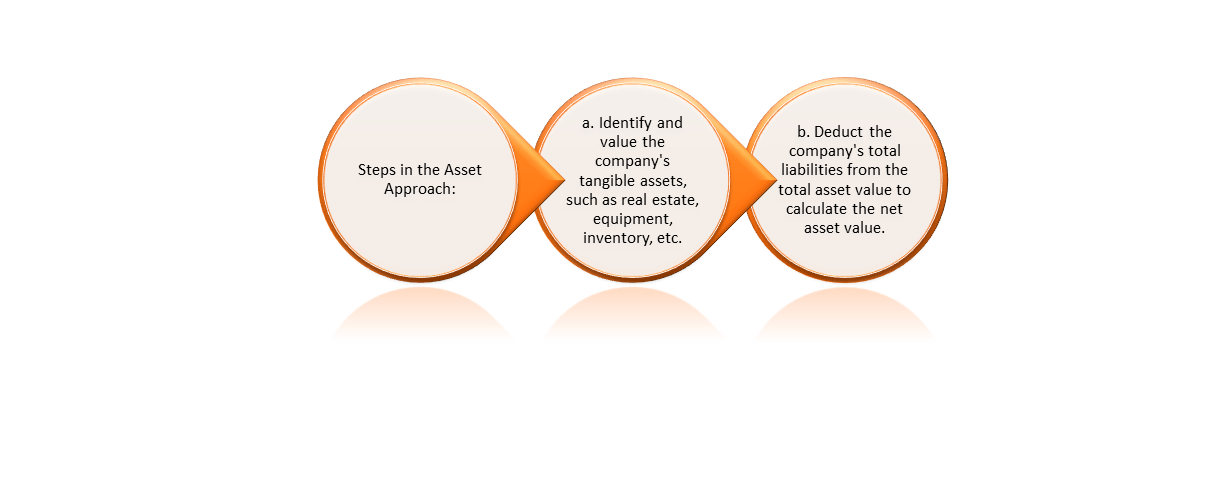Business Valuation Methods: An Overview
Business valuation
is a process used to determine the economic value of a company or business entity. Various approaches and methods are employed to estimate the worth of a business. Below is an overview of the main valuation approaches, each with its corresponding methods and steps.
Asset Approach:
The asset-based approach focuses on valuing a company based on its net asset value (NAV) or the fair market value (FMV) of its total assets minus total liabilities. This approach is suitable for companies with significant tangible assets.

Steps in the Asset Approach:
a. Identify and value the company’s tangible assets, such as real estate, equipment, inventory, etc.
b. Deduct the company’s total liabilities from the total asset value to calculate the net asset value.
Net Asset Value (NAV) Approach:
The NAV approach is a refined version of the asset approach, which considers various factors to calculate the Adjusted NAV of the business.
Steps in the Net Asset Value Approach:
a. Determine the fair value of assets and liabilities.
b. Account for contingent liabilities, tax shields on accumulated losses, and the impact of auditor qualifications and due diligence.
c. Factor in any money to be received from warrants, stock options, and corresponding shares.
Income Approach:
The income-based approach values a company based on its expected future cash flows. It assumes that the current value of a business depends on the future benefits it can generate.
Steps in the Income Approach:
a. Forecast the company’s future cash flows.
b. Choose an appropriate discount rate to adjust future cash flows for the time value of money and risk.
c. Discount the forecasted cash flows to their present value.
Capitalization of Cash Flow Approach:
The capitalization of cash flow approach is a specific method within the income
approach. It is suitable for businesses with stable margins and growth.
Steps in the Capitalization of Cash Flow Approach:
a. Determine an appropriate capitalization rate based on the required return on investment and the risk associated with the business.
b. Calculate the earnings figure to be capitalized, reflecting the true nature of the business.
c. Capitalize the cash flows using the calculated capitalization rate.
Discounted Cash Flow (DCF) Approach:
The DCF approach is another method within the income approach, widely used to value businesses as going concerns. It estimates future cash flows and discounts them to present value.
Steps in the Discounted Cash Flow Approach:
a. Forecast the company’s future cash flows.
b. Determine an appropriate discount rate, considering the business risk and expected return.
c. Discount the projected cash flows to their present value.
Market Approach:
The market approach values a company by comparing it to similar companies in the same industry and region.
Steps in the Market Approach:
a. Identify comparable companies within the industry.
b. Collect market data, such as price-to-earnings ratios or price-to-book ratios of the comparable companies.
c. Apply the valuation multiples to the subject company’s relevant financial metrics to estimate its value.
Comparable Transaction Multiples Method:
The Comparable Transaction Multiples Method (CCMM) is a subset of the market approach. It values a company based on the valuation ratios observed in comparable transactions.
Steps in the Comparable Transaction Multiples Method:
a. Identify similar transactions involving companies with comparable characteristics.
b. Calculate the valuation ratios (e.g., enterprise value-to-EBITDA) from these transactions.
c. Apply the relevant valuation multiple to the subject company’s financial metric to determine its value.
Market Value Method:
The market value method relies on the quoted prices of a company’s shares on the stock exchange.
Steps in the Market Value Method:
a. Obtain the average quoted price of the company’s shares.
b. Use the average price as an indicator of the company’s value as perceived by investors in the free market.
The selection of the appropriate valuation method depends on the specific circumstances and nature of the business being valued. Professional valuation experts often employ a combination of methods to arrive at a comprehensive and well-supported valuation conclusion.
We are a Investment banking & Valuation Firm, having a Pan India presence. Our team of analysts possess cross industry expertise and we have conducted overseas valuations as well.
- Business Valuation
- ESOP accounting- Intrinsic Value and Black Scholes
- ESOP for Taxation
- Acquisition – Domestic & Cross Border
- Merger – Assessment of Swap Ratio
- Fairness Opinion
- Valuation for spinooff/restructuring
- Share Purchase / Investment/Fund Raising
- Good will & Asset Impairment testing (US GAAP/ IFRS/Indian GAAP)
- Foresnsic Valuations including court cases and legal proceedings
- Valuations for Family settlements
- Brand valuation
- Intellectual property valuation
- Asset valuation for purchase price allocation (US GAAP/IFRS)
- Carried Interest valuation
- Derivative Valuation under IFRS
- Share Purchase / Investment/Fund Raising
- Fund raising
- All Other Type of Valuation
- Corporate Finance
- Registered valuer

